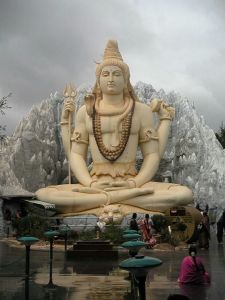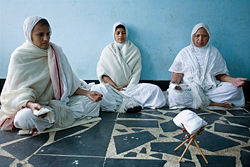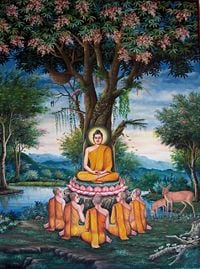Asceticism describes a life characterized by abstinence from worldly pleasures. Those who practice ascetic lifestyles often perceive their practices as virtuous and pursue them to achieve greater spirituality. Many ascetics believe the action of purifying the body helps to purify the soul, and thus obtain a greater connection with the Divine or find inner peace. This may take the form of rituals, the renunciation of pleasure, or self-mortification. However, ascetics maintain that self-imposed constraints bring them greater freedom in various areas of their lives, such as increased clarity of thought and the ability to resist potentially destructive temptations.
The term "ascetic" derives from the ancient Greek word askÄsis (practice, training, or exercise), which refers the regimen many Greek warriors and athletes followed to attain optimal bodily fitness and grace.
Historically, there have been two main categories of asceticism: "Otherworldly" asceticism is practiced by people, including monks, yogis and hermits, who withdraw from the world in order to live an ascetic life; famous examples include Lao Zi, Gautama Buddha, and Francis of Assisi. Such men forsook their families, possessions, and homes to live an ascetic life, and according to their followers, achieved spiritual enlightenment. "Worldly" asceticism refers to those who live ascetic lives but don't withdraw from the world; for example Mahatma Gandhi and many Roman Catholic priests have made asceticism the personal foundation for their work in society.
Most religionsâHinduism, Jainism, Buddhism, Christianity, Islam and Judaismâhave ascetic traditions. However, some people have secular motivations to follow an ascetic lifestyle, such as an artist who deprives himself to clarify his mind for his work or the athlete who deprives himself during training to be at top form for the contest.
Types of religious asceticism
Asceticism is most commonly associated with monks, yogis, or certain types of priests. However any individual may choose to lead an ascetic life. Lao Zi, Shakyamuni Gautama, Mahavir Swami, Saint Anthony, Francis of Assisi, and Mahatma Gandhi are among the best known ascetics. Every major religion and most smaller religious groups have ascetic traditions.
Hinduism

In Hinduism, "The Eternal Way" (in Sanskrit सनातन धरà¥à¤®, SanÄtana Dharma), speaks to the idea that certain spiritual principles hold eternally true, transcending man-made constructs, representing a pure science of consciousness. This consciousness is not merely that of the body or mind and intellect, but of a supra-mental spiritual state that exists within and beyond our existence, the unsullied Self of all. Sadhus, men believed to be holy, are known for extreme forms of self-denial. The particular types of asceticism involved vary from sect to sect, and from holy man to holy man.
There are several forms of yoga practiced in Hinduism. Raja yoga (or meditational union) is based on the sage Patanjali's influential text the Yoga Sutra, which is essentially a compilation and systematization of previous meditational yogi philosophy. The Upanishads and Bhagavad Gita are also indispensable literature in the study of yoga.
The goal of Raja Yoga is clearly stated in the opening verse of the Yoga Sutra: citti vritti nirodha ("cessation of mental fluctuations"). Realization of this goal is known as samadhi. A primary means of the attainment of samadhi is sanyÄsaâmeaning "renunciation" or "abandonment."
Unlike monks in the Western world, whose lives are regulated by a monastery or an abbey and its rules, the Hindu sannyasin is usually a lone personage and a wanderer (parivrÄjaka). Hindu monasteries (mathas) do not have a large number of monks living under one roof. The monasteries exist primarily for educational purposes and have become centers of pilgrimage for the lay population. Most traditional Hindu orders do not have women sannyasis, but this situation is undergoing changes in recent times.
Jainism
Jainism is a specifically ascetic religion with its origins in the prehistory of India and is still practiced today by several million people. Like Hindu asceticism, Jainism encourages fasting, yoga practices, meditation in difficult postures, and other austerities. Also, as in the Hindu tradition, one's highest goal should be moksha (i.e., liberation from the cycle of birth and rebirth). For this, a soul has to be completely passionless and without attachment. This can be achieved only by the monks and nuns who take five great vows: non-violence, truth, non-stealing, non-possession, and celibacy.
Many of Jainism's ascetic practices can be traced back to Vardhaman Mahavira. The Acaranga Sutra, or "Book of Good Conduct," is a sacred book within Jainism that discusses the ascetic code of conduct. Since Jain ascetics practice complete non-violence, they do not hurt any living animal being, be it an insect or a human. Some Jains wear a cloth over the mouth to prevent accidental harm to airborne germs and insects.
Jain monks and nuns travel barefoot from city to city, often crossing forests and deserts. They sleep on the floor without blankets and sit on special wooden platforms. To prevent attachment to any place, Jain ascetics do not stay in a single place for more than two months, except during four months of monsoon (rainy season), they continue to stay at a single place to avoid killing of life forms that thrives during the rains.
Jains follow a strict vegetarian diet without root vegetables. Fasting is a routine feature of Jain asceticism, with fasts lasting for a day or longer, up to a month. Some monks avoid or limit medicine and hospitalization out of disregard for the physical body. Other austerities include meditation in seated or standing posture near river banks in the cold wind, or meditation atop hills and mountains, especially at noon when the sun is at its fiercest. Such austerities are undertaken according to the physical and mental limits of the individual ascetic.
Almost completely without possessions, some Jains own only unstitched white robes and a bowl used for eating and collecting alms. Jain monks and nuns also practice complete celibacy. They do not touch or share a sitting platform with a person of the opposite sex. Every day is spent either in study of scriptures, meditation, or teaching.
Buddhism
As with Hinduism and Jainism, the aim of Buddhist practice is to end the suffering of cyclic existenceâsamsaraâby awakening the practitioner to the realization of true reality, the achievement of spiritual liberation (nirvana). To achieve this, one must purify and train the mind and act according to the laws of karma by performing positive, wholesome actions, and avoiding negative, harmful actions.
According to Buddhist texts, Siddhartha Gautama (c. 563âc. 483 B.C.E.), the founder of Buddhism, was born into a royal family and raised in the lap of luxury. Upon learning of the true nature of the world outside his insulated lifeâa world full of suffering, sickness, old age, and deathâGautama immediately renounced his privileged life, left his family, and joined a group of ascetics in the jungle.
The time of the Buddha seems to have been one in which many different renunciatory groups in the uninhabited regions of north India experimented with various techniques-âascetic, yogic, philosophical, and meditational-âto attain release from suffering and rebirth. Early Buddhist texts are replete with references to ascetics of various types.
According to some versions of the life of the Buddha, Gautama connected with such a group and mastered the radical ascetic regimen they advocated, to such an extent that he ate virtually nothing and shriveled to skin and bones. Finding that he had not achieved his goal through such austerities, Gautama rejected the ascetic path and pursued what he called the "middle way" between the poles of sensuality and asceticism.
Buddhism is thus somewhat ambivalent about the usefulness of asceticism. On the one hand, it rejects the extreme forms of physical self-denial that appear in the other Indian religions it grew up with. On the other hand, there can be no question that Buddhism requires its more serious practitioners not only to renounce worldly life but also to train diligently in self-discipline and self-control through the "eightfold path" (right views, intention, speech, action, livelihood, effort, mindfulness, and concentration).
While the Buddha rejected the extreme forms of physical asceticism recommended by others, he did allow for a number of ascetic practices called the dhutangas. These practices are said not to be the path itself, but only preparatory for the path; they help the seeker eliminate all forms of attachment. The dhutangas include wearing only monastic robes made from discarded fabric, living only on alms begged for indiscriminately, eating only once a day, living in the forest or at the foot of a tree or in a cemetery, and sleeping only while sitting upright.
The main form that asceticism took in Buddhism was monastic renunciation of the world. In stark contrast to the Hindu system of the four stages of life, in which renunciation was relegated to the end of life after the householder stage, Buddhists insisted that as soon as one recognized that this world is like a "house on fire," one should give up the worldly life and join the monastery. There, in the company of other monks or nuns, one could pursue a regulated life of study, meditation, and self-discipline similar to the monastic lifestyle pursued in other religious traditions.
Mahayana Buddhism tends to be less ascetic in its orientation than Theravada Buddhism. The purpose of life for Theravadins is to become an arhat, a perfected saint who has achieved nirvana and will not be reborn again. As a result, this "Southern" Buddhism tends to be more monastic, strict, and world-renouncing than its Northern counterpart. In Theravada, it is thought to be highly unlikely, even impossible, that a layperson can achieve liberation. Because Mahayana disagrees, it regards itself as providing a "Greater Vehicle" to liberation, in which more people can participate.
Judaism
The history of Jewish asceticism goes back thousands of years with references to the Nazirite vow of refraining from cutting one's hair or beard and not partaking of grapes or wine (Numbers 6), as well as the "wilderness tradition" of prophets living in the desert, fasting on mountaintops, or engaging in various other types of self-denial. For example, both Moses and Elijah fasted for 40 days on Mount Sinai, Jeremiah did not marry (Jeremiah 16:2), Isaiah went naked for three years (Isaiah 20), and Ezekiel lay on his side for 390 days, eating only bread (Ezekiel 4:9).
After the Jews returned from the Babylonian exile and the prophetic institution faded, a new form of asceticism evolved in protest to the worldliness and corruption of the priesthood of the Hasmonean dynasty of the second and first century B.C.E. The Essene sect arose under the banner of priestly asceticism, culminating in the Dead Sea Sect. Certain members of this group practiced celibacy, and its priest adhered to a rigid interpretation of the priestly purification laws and dietary restrictions.
Among the rabbis of the Talmud, some are mentioned as great and consistent fasters. The second century sage Simeon ben Yochai is depicted as an ascetic, and Rabbi Zeira especially is remembered for his fondness of this form of piety. The story goes that he abstained from drink and food for the period of 100 days, in order that hell-fire might later have no power over him. Simeon ben Yochai is regarded as the founder of Kabbala, esoteric Jewish mystical doctrine and practices, which included considerable asceticism. Some of kabbalists reportedly would spend the whole week in fasting, rendering only the Sabbath a day of comfort and joy, with the purpose of hastening the arrival of the Messianic era.
There are various biblical allusions to days of fasting in Israelite times (Psalm 109:24, Nehemiah 9:1, Esther 4:3, etc). Yet apart from the prescribed fast on the Day of Atonement, Yom Kippur, mainstream Judaism rejects asceticism as contrary to God's wishes for the world, which is meant to be enjoyed within prescribed limits.
Christianity
Asceticism within Christian tradition is the set of disciplines practiced to work out the believer's salvation and further the believer's repentance as well as for the purpose of spiritual enlightenment. Although monks and nuns are known for especially strict acts of asceticism, ascetic practices are evident among other early Christians.
Scriptural examples of asceticism can be found in the lives of John the Baptist and Jesusâboth of whom fasted for 40 days. Jesus instructed his disciples to fast (Matthew 6:16) and sell their possessions (Matthew 19:21), Saint Paul was celibate, and the primitive Jewish-Christian community in Jerusalem (Acts 4:32) had a tradition of no personal ownership, as well as periods of prayer and fasting (Acts 13:2). Christian authors of late antiquity such as Origen, Jerome, John Chrysostom, and Augustine interpreted meanings of Biblical texts within a highly ascetic religious environment. Through their commentaries, they created an asceticized version of Christianity.
Some early Christians believed that asceticism was the only true way to salvation. This doctrine was rejected as heretical, by the orthodox church, but the ascetic life was preserved through the institution of monasticism.
Thus, the asceticism of practitioners like Jerome was hardly original, and a desert ascetic like Saint Antony the Great (251-356 C.E.) was in the tradition of ascetics in noted communities and sects of the previous centuries. Emphasis on an ascetic religious life is evident in both early Christian writings (Philokalia) and the Eastern Christian practice of hesychasm. Other well known Christian ascetics include Simeon Stylites, Theresa of Avila, Francis of Assisi, Claire of Assisi and numerous others. Indeed, Christian ascetics remain numerous in the modern world in both Catholic and Orthodox monasteries which allow for varying degrees of ascetic lifestyles. Protestant ascetics are more rare, but they do exist. The sociologist Max Weber held that the Protestant work ethic was a form of Protestant asceticism, and some individual Protestants do engage in periods of fasting, sexual abstinence, and other ascetic practices.
Sexual abstinence was merely one aspect of ascetic renunciation. The ancient monks and nuns had other, equally weighty concerns: pride, humility, compassion, discernment, patience, judging others, prayer, hospitality, and almsgiving. For some early Christians, gluttony represented a more primordial problem than sex, and as such the reduced intake of food is also a facet of asceticism. As an illustration, the systematic collection of the Apophthegmata, or Sayings of the Desert Fathers and mothers has more than 20 chapters divided by theme; only one chapter is devoted to porneia (âsexual lust").
Islam
The Islamic word for asceticism is zuhd. The Prophet Muhammad reportedly advised people to live simple lives and he himself practiced great austerities. Even when he had become the virtual king of Arabia, he lived an austere life bordering on privation. His wife Ayesha said that most days he did not even eat two full meals.[1] However, mainline Muslim tradition opposes extreme forms of asceticism.
A major exception to this rule is the practice of fasting during Ramadan. During the ninth month of the Islamic calendar, daytime fasting (sawm) is practiced by most observant Muslims. Every day during the month of Ramadan, no Muslim is supposed to eat or drink during daylight hours or have sexual relations. Muslims around the world get up before dawn to eat (sahur) and perform their fajr prayer. They break their fast when the fourth prayer of the day, Maghrib (sunset), is due.
During Ramadan, Muslims are also expected to put more effort into following the teachings of Islam as well as refraining from lying, stealing, anger, envy, greed, lust, sarcastic retorts, backbiting, and gossip. Obscene and irreligious sights and sounds, and sex are to be avoided. (Qur'an 2:187) Purity of both thought and action is considered important. The fast is intended to be an exacting act of deep personal worship in which Muslims seek a raised level of closeness to God. In addition to prayer and fasting, Muslims are encouraged to read the entire Qur'an during Ramadan.
Sufismâa mystical movement within Islamâmay have evolved as an ascetic movement. The name Sufi refers to a rough woolen robe of the ascetic. Through meditation on the Qur'an and praying to Allah, the Muslim ascetic believes that he draws near to Allah, and by leading an ascetic life paves the way for absorption in Allah, the Sufi way to salvation.
Early Muslim ascetics focused on introspection and maintained a strict control over their life and behavior. They followed a lifestyle of modesty, temperance, contentment and the denial of luxury. Their practices included fasting, wearing light clothing in the depths of winter, or withdrawing themselves from the world.
If early Sufism arose out of the practice of asceticismâthe turning away from worldly life to concentrate on prayer to Allahâthen it likely resulted in being limited to a small number of devoted practitioners. By the middle of the ninth century, Sufi mysticism started to burgeon. One major figure and catalyst in its growth was the female mystic Rabiah al-Adawiyah (died in 801), who emphasized the absolute love for Allah above everything else. The shift of Sufism from asceticism to divine love captured the attention of the masses and elites, and soon Sufism began to flourish in Baghdad spreading then to Persia, Pakistan, India, North Africa, and Muslim Spain.
Religious versus secular motivation
Observation of ascetic lifestyles has its beginnings in both religious and secular settings. For example, the religious motivations of the ancient Hebrew sects, fasting in order to become Holy, priestesses in the temples of ancient Greece abstaining from sex to better serve their particular god, and Stoic philosophers disciplining their will against a life of sensual pleasure to achieve spiritual goals, is balanced by the examples of Spartans undertaking regimens of severe physical discipline to prepare for battle and the belief in Rome that the purity of the Vestal Virgins was a safeguard against harm to the city.
Secular motivation
Examples of secular asceticism:
- A "Starving Artist" is someone who minimizes their living expenses in order to spend more time and effort on their art.
- Eccentric inventors sometimes live similar lives in pursuit of technical rather than artistic goals.
- "Hackers" often consider their programming projects to be more important than personal wealth or comfort.
- Various individuals have attempted an ascetic lifestyle to free themselves from modern-day addictions, such as alcohol, tobacco, drugs, fast food, gambling, and sex.
- Many professional athletes abstain from sex, rich foods, and other pleasures before major competitions in order to mentally prepare themselves for the upcoming contest.
Notes
- â Athar Saeed Naqvi, Human Self: In the Light of Physics and Quran (Balboa Press, 2018, ISBN 978-1504394888).
ReferencesISBN links support NWE through referral fees
- Brakke, David. Athanasius and Asceticism. The Johns Hopkins University Press, 1998. ISBN 978-0801860553
- Chadwick, Owen. Western Asceticism. Westminster John Knox Press, 1979. ISBN 978-0664241612
- Cole, Letha B. & Winkler, Mary G. The Good Body: Asceticism in Contemporary Culture.. Yale University Press, 1994. ISBN 978-0300056280
- Naqvi, Athar Saeed. Human Self: In the Light of Physics and Quran. Balboa Press, 2018. ISBN 978-1504394888
- Wimbush, Vincent L. & Richard Valantasis. Aceticism. Oxford University Press, 2002. ISBN 0195151380
External links
All links retrieved August 18, 2023.
- St. Simeon Stylites by George Lamb. www.panmodern.com.
- Asceticism Catholic Encyclopedia.
- Asceticism Jewish Encyclopedia.
Credits
New World Encyclopedia writers and editors rewrote and completed the Wikipedia article in accordance with New World Encyclopedia standards. This article abides by terms of the Creative Commons CC-by-sa 3.0 License (CC-by-sa), which may be used and disseminated with proper attribution. Credit is due under the terms of this license that can reference both the New World Encyclopedia contributors and the selfless volunteer contributors of the Wikimedia Foundation. To cite this article click here for a list of acceptable citing formats.The history of earlier contributions by wikipedians is accessible to researchers here:
The history of this article since it was imported to New World Encyclopedia:
Note: Some restrictions may apply to use of individual images which are separately licensed.




